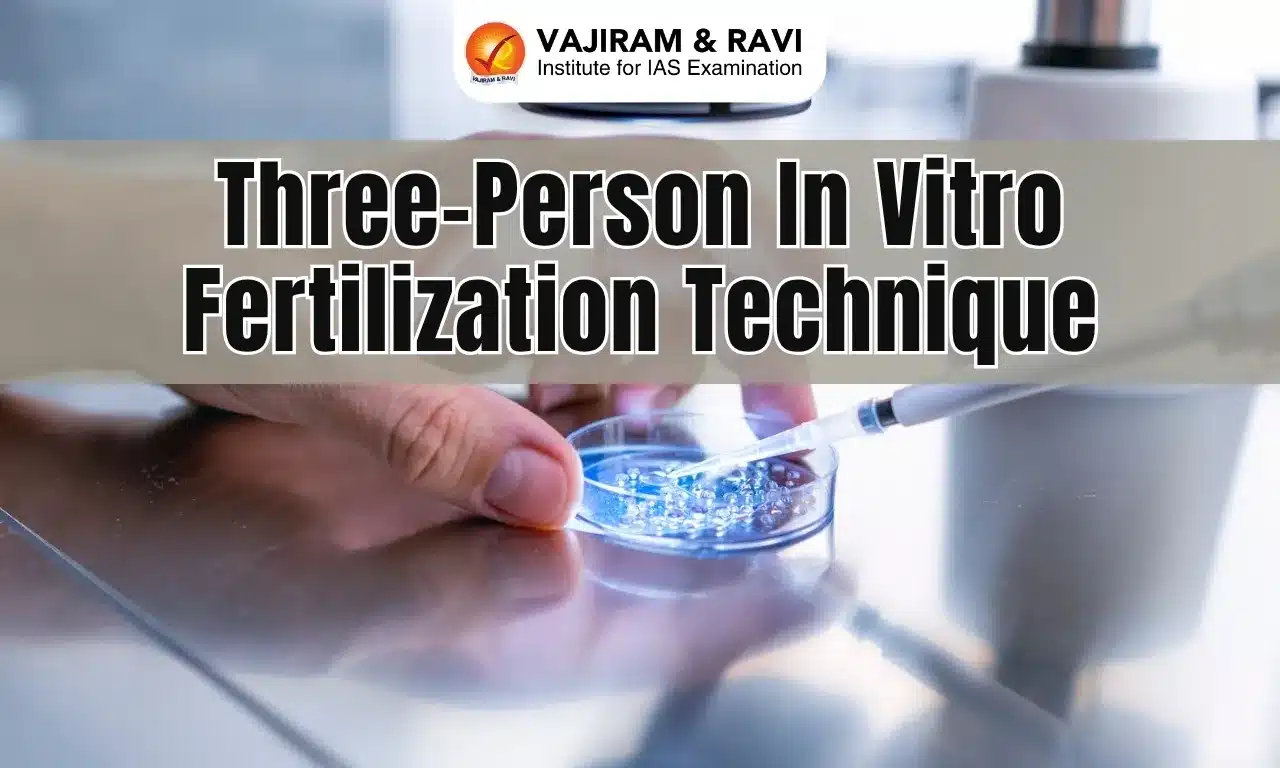Three-Person In Vitro Fertilization Technique Latest News
Eight children in the UK have been spared from devastating genetic diseases thanks to a new three-person in vitro fertilization technique, scientists reported recently.
What is In Vitro Fertilization (IVF)?
- It is a medical procedure used to assist individuals or couples who are facing fertility challenges in achieving pregnancy.
- IVF is the most common and effective type of assisted reproductive technology (ART).
- Process:
- IVF is a complex process that involves retrieving eggs from ovaries and manually combining them with sperm in a lab for fertilization.
- Several days after fertilization, the fertilized egg (now called an embryo) is placed inside a uterus.
- Pregnancy occurs when this embryo implants itself into the uterine wall.
- The procedure can be done using a couple’s own eggs and sperm. Or IVF may involve eggs, sperm or embryos from a known or anonymous donor.
- The success rate of IVF depends on a number of factors, including reproductive history, maternal age, the cause of infertility, and lifestyle factors.
About Three-Person In Vitro Fertilization
- Most DNA is found in the nucleus of our cells, and it’s that genetic material—some inherited from mom, some from dad — that makes us who we are.
- But there’s also some DNA outside of the cell’s nucleus, in structures called mitochondria.
- Dangerous mutations there can cause a range of diseases in children that can lead to muscle weakness, seizures, developmental delays, major organ failure and death.
- These disorders are inherited exclusively through the mother, as mitochondrial DNA is passed down maternally.
- While men can suffer from mitochondrial disease, they do not transmit it to their children.
- Currently, there is no cure for mitochondrial DNA disorders.
- The three-person IVF technique offers a promising solution to this.
- It involves a procedure in which the nucleus from the mother’s fertilized egg, along with the father’s sperm, is transferred into a healthy donor egg that has had its own nucleus removed.
- This process allows the child to inherit nuclear DNA from the biological parents and healthy mitochondrial DNA from the donor.
- The procedure essentially replaces the faulty mitochondrial material in the mother’s egg with healthy mitochondria from the donor.
- Therefore, the mother with the mitochondrial condition is still the biological mother of her child.
- In fact, the egg donor’s DNA only accounts for about .2% of the baby’s genetics.
Source: DDN
Last updated on January, 2026
→ Check out the latest UPSC Syllabus 2026 here.
→ Join Vajiram & Ravi’s Interview Guidance Programme for expert help to crack your final UPSC stage.
→ UPSC Mains Result 2025 is now out.
→ UPSC Notification 2026 is scheduled to be released on January 14, 2026.
→ UPSC Calendar 2026 is released on 15th May, 2025.
→ UPSC Prelims 2026 will be conducted on 24th May, 2026 & UPSC Mains 2026 will be conducted on 21st August 2026.
→ The UPSC Selection Process is of 3 stages-Prelims, Mains and Interview.
→ UPSC Result 2024 is released with latest UPSC Marksheet 2024. Check Now!
→ UPSC Toppers List 2024 is released now. Shakti Dubey is UPSC AIR 1 2024 Topper.
→ Also check Best IAS Coaching in Delhi
Three-Person In Vitro Fertilization FAQs
Q1. How is mitochondrial DNA inherited?+
Q2. What is the main objective of the Three-Person In Vitro Fertilization technique?+
Q3. In the Three-Person In Vitro Fertilization, the donor contributes:+
Q4. What part of the mother’s egg is replaced during the Three-Person In Vitro Fertilization process?+
Q5. What happens to the donor egg’s nucleus during the Three-Person In Vitro Fertilization?+

















